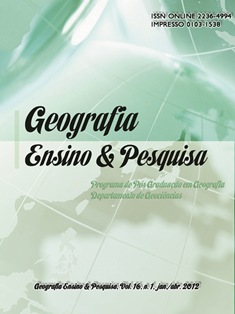The dynamics of geomorphological slopes and their implications for road infrastructure: some examples in Northern Portugal
DOI:
https://doi.org/10.5902/223649947323Abstract
The presence of man and his action on the territory is a major factor of instability, as their increasingly aggressive interventions have strong implications, altering the natural conditions of occurrence of various types of morphogenetic processes. In natural terms, in northern Portugal, is possible the occurrence of different types of mass movements on slopes with a predominance of steep slopes (18 ° to 35 °) whose susceptibility increases with the coexistence of surface formations. This fact gets worse when the man in his performance over the territory, changes the natural condition implying a higher probability of occurrence of these same processes in sections where the slopes are presented below. The construction of road infrastructure on steep slopes is with no margin for doubt, a practice that contributes most to change the dynamics of the same, contributing to its dynamic disequilibrium. Indeed, based on work we have been doing, we found that even in places where these natural factors are favorable to the emergence of geomorphological processes is, however, human intervention that will allow the triggering event, contributing to increase the risk. The objective of this paper is to prove that many of the mass movements in northern Portugal, are directly related to human activity on the territory that profoundly modifies the profile of the slopes and introduce changes in the natural dynamics. The aim of this work, discuss what the causes and factors that contribute to triggering of mass movements on slopes in northern Portugal, and the importance of action of man in its occurrence, so that in future interventions, to avoid the disruption of the dynamic equilibrium of the slopes.Downloads
Downloads
Published
How to Cite
Issue
Section
License
The journal Geografia – Ensino & Pesquisa will obtain the auctorial rights for all published texts. This also implies that the text can be published anywhere in the world, including all rights on renewal, expansion and dissemination of the contribution, as well as other subsidiary rights. The author’s get permission to publish the contribution in other medias, printed or digital, may be in Portuguese or translation, since the publication is credited to Revista Geografia – Ensino & Pesquisa.The journal Geografia – Ensino & Pesquisa will obtain the auctorial rights for all published texts. This also implies that the text can be published anywhere in the world, including all rights on renewal, expansion and dissemination of the contribution, as well as other subsidiary rights. The author’s get permission to publish the contribution in other medias, printed or digital, may be in Portuguese or translation, since the publication is credited to Revista Geografia – Ensino & Pesquisa.







